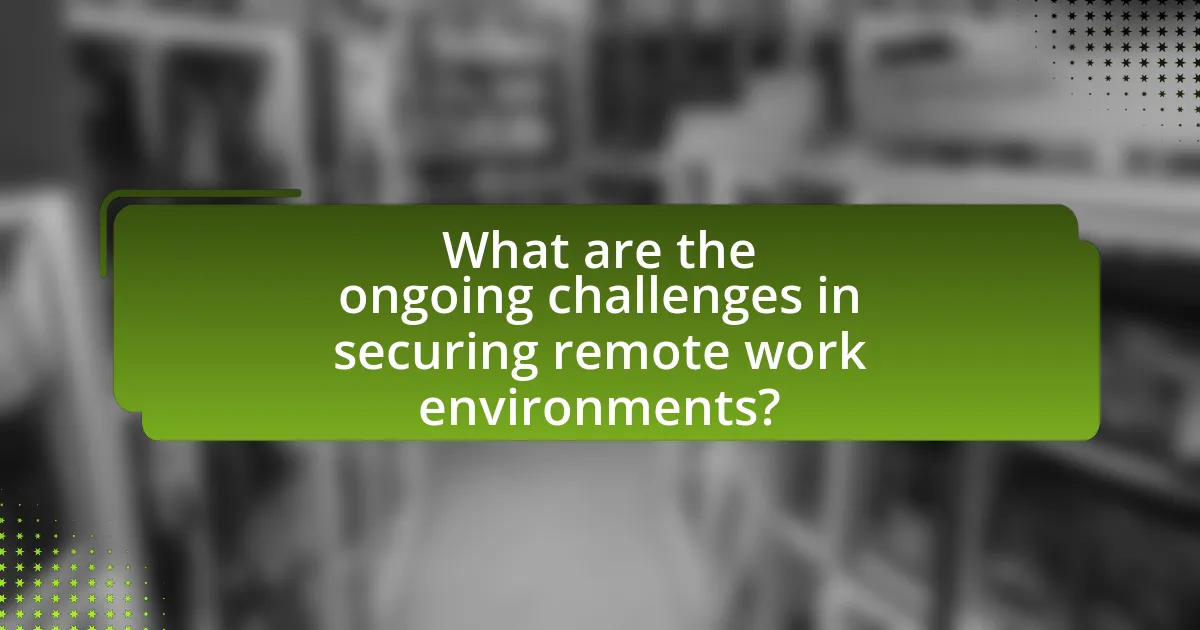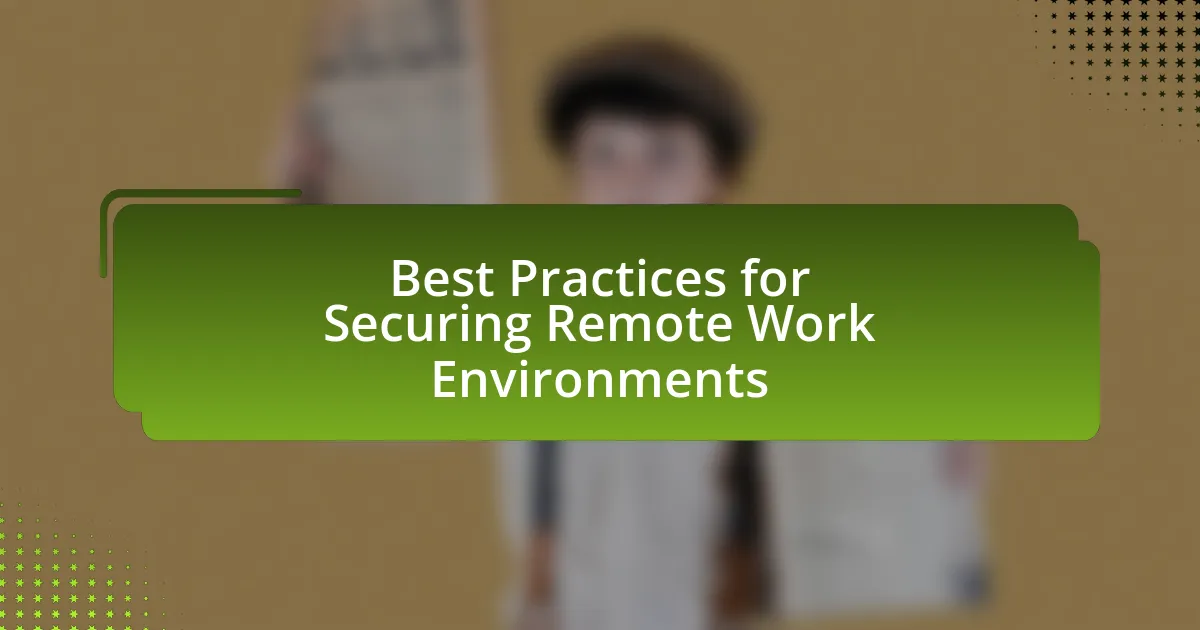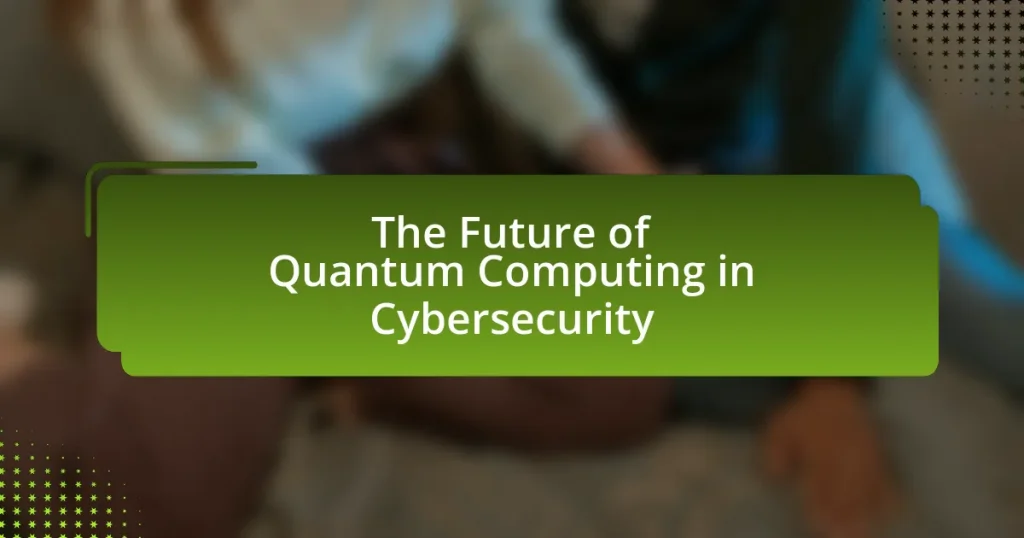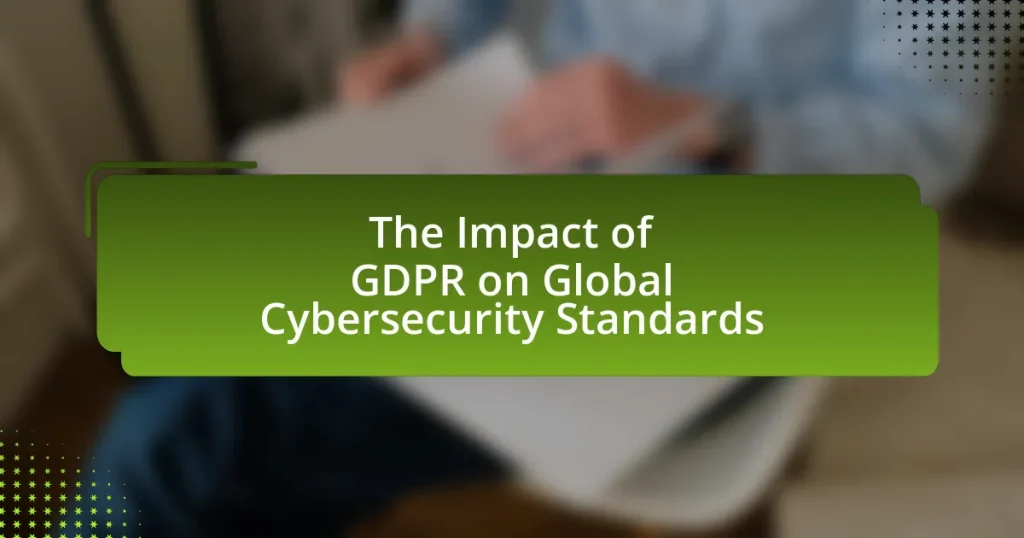The article focuses on best practices for securing remote work environments, emphasizing the importance of strong password policies, multi-factor authentication, and regular software updates to mitigate cybersecurity risks. It outlines the essential components of a secure remote work setup, including secure network connections, data encryption, and employee training on security protocols. The article also addresses the risks associated with remote work, such as increased vulnerability to cyberattacks and the impact of security breaches on organizations. Additionally, it highlights the significance of compliance with regulations like GDPR and HIPAA, and provides practical tips for enhancing security in remote work settings.

What are the Best Practices for Securing Remote Work Environments?
The best practices for securing remote work environments include implementing strong password policies, utilizing multi-factor authentication, and ensuring regular software updates. Strong password policies require employees to create complex passwords and change them regularly, reducing the risk of unauthorized access. Multi-factor authentication adds an additional layer of security by requiring a second form of verification, such as a text message or authentication app, which significantly decreases the likelihood of account breaches. Regular software updates are crucial as they patch vulnerabilities that could be exploited by cybercriminals, with studies showing that 60% of breaches involve unpatched software. Additionally, providing cybersecurity training for employees helps them recognize phishing attempts and other threats, further enhancing the security of remote work environments.
Why is securing remote work environments essential?
Securing remote work environments is essential to protect sensitive data and maintain organizational integrity. With the rise of remote work, cyber threats have increased significantly; for instance, a report by Cybersecurity Ventures predicts that cybercrime will cost the world $10.5 trillion annually by 2025. This underscores the necessity for robust security measures to prevent data breaches, unauthorized access, and potential financial losses. Additionally, securing remote work environments helps ensure compliance with regulations such as GDPR and HIPAA, which mandate the protection of personal and sensitive information.
What risks are associated with remote work?
Remote work is associated with several risks, including cybersecurity threats, isolation, and decreased productivity. Cybersecurity threats arise from unsecured home networks and personal devices, which can lead to data breaches; a report by Cybersecurity & Infrastructure Security Agency indicates that remote work increases vulnerability to phishing attacks by 30%. Isolation can negatively impact mental health and team cohesion, as employees may feel disconnected from their colleagues, leading to decreased morale. Additionally, decreased productivity can occur due to distractions at home, with studies showing that remote workers may struggle to maintain focus compared to their in-office counterparts.
How do security breaches impact organizations?
Security breaches significantly impact organizations by compromising sensitive data, leading to financial losses, reputational damage, and legal consequences. For instance, the 2020 IBM Cost of a Data Breach Report revealed that the average cost of a data breach was $3.86 million, highlighting the financial burden organizations face. Additionally, breaches can erode customer trust; a 2021 survey by PwC found that 87% of consumers would take their business elsewhere if they felt their data was not secure. Legal ramifications also arise, as organizations may face fines and lawsuits due to non-compliance with regulations like GDPR or HIPAA. Thus, security breaches can have far-reaching effects on an organization’s operational integrity and market position.
What are the key components of a secure remote work environment?
The key components of a secure remote work environment include strong authentication methods, secure network connections, regular software updates, data encryption, and employee training on security protocols. Strong authentication methods, such as multi-factor authentication, significantly reduce unauthorized access risks. Secure network connections, like Virtual Private Networks (VPNs), protect data transmitted over the internet. Regular software updates ensure that vulnerabilities are patched, while data encryption safeguards sensitive information from unauthorized access. Employee training on security protocols enhances awareness and compliance, reducing the likelihood of human error leading to security breaches. These components collectively create a robust framework for maintaining security in remote work settings.
What technologies are necessary for remote work security?
Technologies necessary for remote work security include Virtual Private Networks (VPNs), firewalls, endpoint security solutions, multi-factor authentication (MFA), and secure collaboration tools. VPNs encrypt internet traffic, ensuring secure connections to corporate networks, while firewalls protect against unauthorized access. Endpoint security solutions safeguard devices from malware and other threats. MFA adds an extra layer of security by requiring multiple forms of verification before granting access. Secure collaboration tools, such as encrypted messaging and file-sharing platforms, protect sensitive information during remote communication. These technologies collectively enhance the security posture of remote work environments, reducing the risk of data breaches and cyberattacks.
How do policies and procedures enhance security?
Policies and procedures enhance security by establishing clear guidelines and protocols that govern behavior and actions within an organization. These frameworks help mitigate risks by ensuring that all employees understand their roles in maintaining security, such as adhering to password policies, recognizing phishing attempts, and following data protection measures. For instance, organizations with documented security policies experience 50% fewer security incidents, as employees are more likely to comply with established protocols when they are clearly defined and communicated.
What role does employee training play in remote work security?
Employee training plays a critical role in enhancing remote work security by equipping employees with the knowledge and skills necessary to recognize and respond to security threats. Effective training programs educate employees about potential risks such as phishing attacks, insecure networks, and data protection protocols. According to a report by the Ponemon Institute, organizations that invest in security awareness training can reduce the likelihood of a data breach by up to 70%. This statistic underscores the importance of training in fostering a security-conscious culture among remote workers, ultimately leading to improved overall security posture for the organization.
How can organizations effectively train employees on security practices?
Organizations can effectively train employees on security practices by implementing a comprehensive training program that includes regular workshops, interactive simulations, and up-to-date resources. Such programs should cover essential topics like phishing awareness, password management, and data protection protocols. Research indicates that organizations with ongoing security training see a 70% reduction in security incidents, highlighting the importance of continuous education. Additionally, incorporating real-world scenarios into training helps employees understand the practical implications of security threats, making them more vigilant and prepared to respond appropriately.
What common security mistakes should employees avoid?
Employees should avoid using weak passwords, as they are easily compromised. Weak passwords often include common phrases or simple sequences, making them vulnerable to brute-force attacks. According to a study by Verizon, 81% of data breaches are linked to weak or stolen passwords. Additionally, employees should refrain from sharing sensitive information over unsecured networks, as this can expose data to interception. Using public Wi-Fi without a VPN increases the risk of unauthorized access to company resources. Lastly, neglecting software updates can leave systems open to exploitation; the National Cyber Security Centre reports that outdated software is a common entry point for cybercriminals.
How can organizations assess their current remote work security measures?
Organizations can assess their current remote work security measures by conducting comprehensive security audits and vulnerability assessments. These evaluations should include reviewing existing security policies, analyzing remote access protocols, and testing the effectiveness of security tools such as firewalls and antivirus software. Additionally, organizations should gather feedback from employees regarding their experiences with security practices and identify any gaps in training or awareness. According to a 2021 report by Cybersecurity & Infrastructure Security Agency, 85% of organizations that regularly assess their security posture are better prepared to mitigate risks associated with remote work.
What are the common vulnerabilities in remote work setups?
Common vulnerabilities in remote work setups include insecure home networks, lack of endpoint security, and inadequate employee training on cybersecurity practices. Insecure home networks often lack proper encryption and security protocols, making them susceptible to unauthorized access. Lack of endpoint security means that devices used for work, such as laptops and smartphones, may not have updated antivirus software or firewalls, increasing the risk of malware infections. Additionally, inadequate employee training can lead to poor password management and susceptibility to phishing attacks, which are prevalent in remote work scenarios. According to a report by Cybersecurity & Infrastructure Security Agency, 90% of data breaches are caused by human error, highlighting the importance of training in mitigating these vulnerabilities.

What specific strategies can enhance remote work security?
Implementing multi-factor authentication (MFA) significantly enhances remote work security by requiring users to provide two or more verification factors to gain access to systems. This strategy reduces the risk of unauthorized access, as even if a password is compromised, additional verification is needed. According to a study by Microsoft, MFA can block over 99.9% of account compromise attacks. Additionally, employing a virtual private network (VPN) encrypts internet traffic, safeguarding sensitive data from potential eavesdroppers. Regular software updates and patch management are also critical, as they address vulnerabilities that could be exploited by cybercriminals. A report from the Cybersecurity and Infrastructure Security Agency (CISA) emphasizes that timely updates can prevent many security breaches. Lastly, conducting regular security training for remote employees ensures they are aware of phishing attacks and other threats, which is vital since human error is a leading cause of security incidents.
How can organizations implement multi-factor authentication?
Organizations can implement multi-factor authentication (MFA) by integrating it into their existing authentication systems and requiring users to provide two or more verification factors to gain access. This can be achieved by utilizing a combination of something the user knows (like a password), something the user has (like a smartphone app or hardware token), and something the user is (like biometric data).
For instance, according to a report by the Cybersecurity & Infrastructure Security Agency (CISA), implementing MFA can reduce the risk of unauthorized access by up to 99.9%. Organizations can start by selecting an MFA solution that aligns with their security needs, training employees on its use, and enforcing MFA across all critical applications and systems.
What are the benefits of multi-factor authentication?
Multi-factor authentication (MFA) significantly enhances security by requiring users to provide multiple forms of verification before accessing accounts. This method reduces the risk of unauthorized access, as it combines something the user knows (like a password) with something they have (like a mobile device) or something they are (like a fingerprint). According to a study by Microsoft, MFA can block over 99.9% of account compromise attacks, demonstrating its effectiveness in protecting sensitive information in remote work environments.
How can organizations encourage the use of strong passwords?
Organizations can encourage the use of strong passwords by implementing mandatory password policies that require complexity, length, and regular updates. These policies should specify that passwords must include a mix of uppercase letters, lowercase letters, numbers, and special characters, with a minimum length of at least 12 characters. Research indicates that organizations with enforced password policies see a significant reduction in security breaches; for instance, a study by Verizon in their 2021 Data Breach Investigations Report found that 81% of hacking-related breaches involved weak or stolen passwords. Additionally, organizations can provide training sessions to educate employees about the importance of strong passwords and the risks associated with weak ones, further reinforcing the need for adherence to these policies.
What are the best practices for securing home networks?
The best practices for securing home networks include using strong, unique passwords for the router, enabling WPA3 encryption, regularly updating firmware, disabling remote management, and utilizing a guest network for visitors. Strong passwords prevent unauthorized access, while WPA3 encryption enhances data security. Regular firmware updates patch vulnerabilities, and disabling remote management reduces exposure to external threats. A guest network keeps personal devices separate from visitors, minimizing risks. According to the Cybersecurity & Infrastructure Security Agency, implementing these measures significantly reduces the likelihood of cyberattacks on home networks.
How can employees secure their Wi-Fi connections?
Employees can secure their Wi-Fi connections by using strong, unique passwords and enabling WPA3 encryption on their routers. Strong passwords should be at least 12 characters long, combining letters, numbers, and symbols, which significantly reduces the risk of unauthorized access. WPA3 encryption is the latest security protocol that provides enhanced protection against brute-force attacks and improves overall network security. According to the Wi-Fi Alliance, WPA3 offers stronger encryption methods and safeguards user data more effectively than previous protocols.
What devices should be secured in a remote work environment?
In a remote work environment, devices that should be secured include laptops, smartphones, tablets, and any other devices that access company networks or sensitive data. Laptops are particularly vulnerable as they often contain confidential information and are frequently used outside secure office environments. Smartphones and tablets also require protection due to their ability to access corporate emails and applications. According to a report by IBM, 95% of cybersecurity breaches are caused by human error, highlighting the importance of securing these devices to prevent unauthorized access and data leaks.
How can data encryption protect sensitive information?
Data encryption protects sensitive information by converting it into a coded format that can only be read by authorized users with the correct decryption key. This process ensures that even if data is intercepted during transmission or accessed without permission, it remains unreadable and secure. For example, the Advanced Encryption Standard (AES) is widely used and recognized for its effectiveness in safeguarding data, as it employs complex algorithms that make unauthorized access extremely difficult. According to a report by the Ponemon Institute, organizations that implement encryption can reduce the risk of data breaches significantly, highlighting its critical role in maintaining data confidentiality and integrity in remote work environments.
What types of data should be encrypted?
Sensitive data should be encrypted, including personal identifiable information (PII), financial records, health information, and confidential business documents. Encrypting PII, such as Social Security numbers and addresses, protects individuals from identity theft. Financial records, including credit card information and bank account details, are vulnerable to fraud and should be secured through encryption. Health information, governed by regulations like HIPAA, requires encryption to maintain patient confidentiality. Additionally, confidential business documents, such as trade secrets and proprietary data, must be encrypted to prevent unauthorized access and maintain competitive advantage.
How can organizations implement encryption effectively?
Organizations can implement encryption effectively by adopting a comprehensive strategy that includes using strong encryption algorithms, ensuring end-to-end encryption for data in transit and at rest, and regularly updating encryption protocols. Strong encryption algorithms, such as AES-256, provide robust security against unauthorized access. End-to-end encryption ensures that only authorized users can access sensitive information, which is crucial for remote work environments where data is often transmitted over unsecured networks. Regular updates to encryption protocols, such as transitioning from outdated standards like SSL 3.0 to TLS 1.2 or higher, mitigate vulnerabilities and enhance security. According to the National Institute of Standards and Technology (NIST), following these practices significantly reduces the risk of data breaches and enhances overall data protection.

What are the ongoing challenges in securing remote work environments?
Ongoing challenges in securing remote work environments include inadequate security protocols, lack of employee training, and increased vulnerability to cyberattacks. Inadequate security protocols arise when organizations fail to implement robust measures such as multi-factor authentication and secure VPNs, which are essential for protecting sensitive data. Lack of employee training contributes to security risks, as employees may not recognize phishing attempts or understand safe online practices, leading to potential breaches. Additionally, increased vulnerability to cyberattacks is evident in the rise of ransomware incidents, with a report from Cybersecurity Ventures predicting that ransomware damage costs will reach $265 billion by 2031. These factors collectively hinder the effectiveness of security measures in remote work settings.
How do evolving threats impact remote work security?
Evolving threats significantly compromise remote work security by introducing new vulnerabilities that can be exploited by cybercriminals. As remote work environments expand, attackers increasingly target unsecured home networks, personal devices, and cloud services, leading to data breaches and unauthorized access. For instance, a report from Cybersecurity & Infrastructure Security Agency (CISA) highlighted that 90% of organizations experienced phishing attacks during the shift to remote work, emphasizing the need for robust security measures. Additionally, the rise of ransomware attacks, which increased by 150% in 2020 according to the FBI, underscores the urgency for organizations to implement comprehensive security protocols, such as multi-factor authentication and regular software updates, to mitigate these evolving threats.
What are the latest trends in cyber threats for remote workers?
The latest trends in cyber threats for remote workers include increased phishing attacks, ransomware targeting remote access tools, and exploitation of unsecured home networks. Phishing attacks have surged, with a 75% increase reported in 2023, as cybercriminals exploit remote work vulnerabilities to gain access to sensitive information. Ransomware attacks have also evolved, with attackers specifically targeting remote access software like VPNs and remote desktop protocols, leading to significant data breaches. Additionally, unsecured home networks present a growing risk, as many remote workers fail to implement adequate security measures, making them easy targets for cyber intrusions. These trends highlight the need for robust cybersecurity practices tailored to remote work environments.
How can organizations stay updated on security threats?
Organizations can stay updated on security threats by implementing continuous monitoring systems, subscribing to threat intelligence services, and participating in cybersecurity forums. Continuous monitoring systems, such as Security Information and Event Management (SIEM) tools, provide real-time analysis of security alerts generated by applications and network hardware. Threat intelligence services, like Recorded Future or FireEye, deliver timely information about emerging threats and vulnerabilities. Additionally, engaging in cybersecurity forums and communities, such as the Information Systems Security Association (ISSA), allows organizations to share insights and learn from the experiences of others in the industry. These methods collectively enhance an organization’s ability to respond proactively to potential security threats.
What measures can be taken to ensure compliance with regulations?
To ensure compliance with regulations in remote work environments, organizations should implement comprehensive security policies and regular training programs. These measures include establishing clear guidelines for data protection, access controls, and incident response protocols. Regular audits and assessments can verify adherence to these policies, while ongoing employee training ensures that staff are aware of regulatory requirements and best practices. For instance, according to a 2021 report by the Ponemon Institute, organizations that conduct regular security training experience 50% fewer data breaches, highlighting the effectiveness of proactive compliance measures.
What regulations should organizations be aware of regarding remote work security?
Organizations should be aware of regulations such as the General Data Protection Regulation (GDPR), the Health Insurance Portability and Accountability Act (HIPAA), and the Federal Information Security Management Act (FISMA) regarding remote work security. GDPR mandates strict data protection and privacy measures for organizations handling personal data of EU citizens, requiring them to implement adequate security measures to protect data during remote work. HIPAA sets standards for protecting sensitive patient information, necessitating secure remote access to health data. FISMA requires federal agencies and their contractors to secure information systems, including those used for remote work, ensuring compliance with federal security standards. These regulations highlight the importance of implementing robust security protocols to protect sensitive information in remote work environments.
How can organizations ensure they meet compliance requirements?
Organizations can ensure they meet compliance requirements by implementing a comprehensive compliance management system that includes regular audits, employee training, and adherence to relevant regulations. A compliance management system helps organizations identify and mitigate risks associated with non-compliance, ensuring that they follow laws such as GDPR or HIPAA. Regular audits, which can be conducted quarterly or annually, provide a systematic review of processes and controls, allowing organizations to address any gaps in compliance. Employee training programs are essential, as they educate staff on compliance policies and procedures, fostering a culture of accountability. According to a study by the Ponemon Institute, organizations with effective compliance training programs experience 50% fewer compliance violations, demonstrating the importance of proactive measures in maintaining compliance.
What practical tips can enhance remote work security?
To enhance remote work security, implement strong password policies, utilize multi-factor authentication, and ensure regular software updates. Strong passwords reduce the risk of unauthorized access, while multi-factor authentication adds an additional layer of security, making it significantly harder for attackers to gain entry. Regular software updates patch vulnerabilities that could be exploited by cybercriminals, thereby protecting sensitive data. According to a report by Verizon, 81% of data breaches are linked to weak or stolen passwords, highlighting the importance of robust password management in securing remote work environments.



